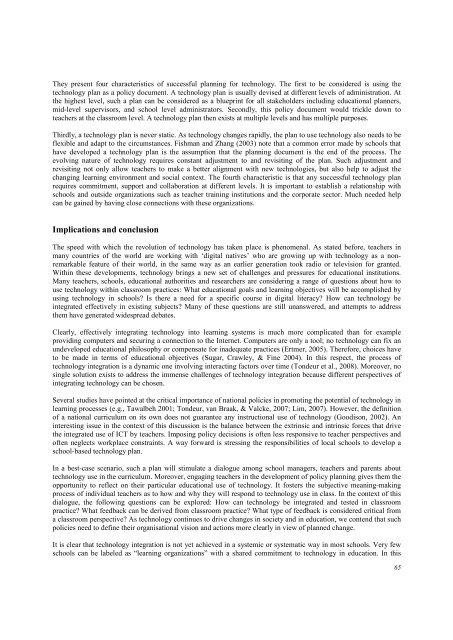Download Complete Issue in PDF - Educational Technology & Society
Download Complete Issue in PDF - Educational Technology & Society
Download Complete Issue in PDF - Educational Technology & Society
You also want an ePaper? Increase the reach of your titles
YUMPU automatically turns print PDFs into web optimized ePapers that Google loves.
They present four characteristics of successful plann<strong>in</strong>g for technology. The first to be considered is us<strong>in</strong>g the<br />
technology plan as a policy document. A technology plan is usually devised at different levels of adm<strong>in</strong>istration. At<br />
the highest level, such a plan can be considered as a bluepr<strong>in</strong>t for all stakeholders <strong>in</strong>clud<strong>in</strong>g educational planners,<br />
mid-level supervisors, and school level adm<strong>in</strong>istrators. Secondly, this policy document would trickle down to<br />
teachers at the classroom level. A technology plan then exists at multiple levels and has multiple purposes.<br />
Thirdly, a technology plan is never static. As technology changes rapidly, the plan to use technology also needs to be<br />
flexible and adapt to the circumstances. Fishman and Zhang (2003) note that a common error made by schools that<br />
have developed a technology plan is the assumption that the plann<strong>in</strong>g document is the end of the process. The<br />
evolv<strong>in</strong>g nature of technology requires constant adjustment to and revisit<strong>in</strong>g of the plan. Such adjustment and<br />
revisit<strong>in</strong>g not only allow teachers to make a better alignment with new technologies, but also help to adjust the<br />
chang<strong>in</strong>g learn<strong>in</strong>g environment and social context. The fourth characteristic is that any successful technology plan<br />
requires commitment, support and collaboration at different levels. It is important to establish a relationship with<br />
schools and outside organizations such as teacher tra<strong>in</strong><strong>in</strong>g <strong>in</strong>stitutions and the corporate sector. Much needed help<br />
can be ga<strong>in</strong>ed by hav<strong>in</strong>g close connections with these organizations.<br />
Implications and conclusion<br />
The speed with which the revolution of technology has taken place is phenomenal. As stated before, teachers <strong>in</strong><br />
many countries of the world are work<strong>in</strong>g with ‘digital natives’ who are grow<strong>in</strong>g up with technology as a nonremarkable<br />
feature of their world, <strong>in</strong> the same way as an earlier generation took radio or television for granted.<br />
With<strong>in</strong> these developments, technology br<strong>in</strong>gs a new set of challenges and pressures for educational <strong>in</strong>stitutions.<br />
Many teachers, schools, educational authorities and researchers are consider<strong>in</strong>g a range of questions about how to<br />
use technology with<strong>in</strong> classroom practices: What educational goals and learn<strong>in</strong>g objectives will be accomplished by<br />
us<strong>in</strong>g technology <strong>in</strong> schools? Is there a need for a specific course <strong>in</strong> digital literacy? How can technology be<br />
<strong>in</strong>tegrated effectively <strong>in</strong> exist<strong>in</strong>g subjects? Many of these questions are still unanswered, and attempts to address<br />
them have generated widespread debates.<br />
Clearly, effectively <strong>in</strong>tegrat<strong>in</strong>g technology <strong>in</strong>to learn<strong>in</strong>g systems is much more complicated than for example<br />
provid<strong>in</strong>g computers and secur<strong>in</strong>g a connection to the Internet. Computers are only a tool; no technology can fix an<br />
undeveloped educational philosophy or compensate for <strong>in</strong>adequate practices (Ertmer, 2005). Therefore, choices have<br />
to be made <strong>in</strong> terms of educational objectives (Sugar, Crawley, & F<strong>in</strong>e 2004). In this respect, the process of<br />
technology <strong>in</strong>tegration is a dynamic one <strong>in</strong>volv<strong>in</strong>g <strong>in</strong>teract<strong>in</strong>g factors over time (Tondeur et al., 2008). Moreover, no<br />
s<strong>in</strong>gle solution exists to address the immense challenges of technology <strong>in</strong>tegration because different perspectives of<br />
<strong>in</strong>tegrat<strong>in</strong>g technology can be chosen.<br />
Several studies have po<strong>in</strong>ted at the critical importance of national policies <strong>in</strong> promot<strong>in</strong>g the potential of technology <strong>in</strong><br />
learn<strong>in</strong>g processes (e.g., Tawalbeh 2001; Tondeur, van Braak, & Valcke, 2007; Lim, 2007). However, the def<strong>in</strong>ition<br />
of a national curriculum on its own does not guarantee any <strong>in</strong>structional use of technology (Goodison, 2002). An<br />
<strong>in</strong>terest<strong>in</strong>g issue <strong>in</strong> the context of this discussion is the balance between the extr<strong>in</strong>sic and <strong>in</strong>tr<strong>in</strong>sic forces that drive<br />
the <strong>in</strong>tegrated use of ICT by teachers. Impos<strong>in</strong>g policy decisions is often less responsive to teacher perspectives and<br />
often neglects workplace constra<strong>in</strong>ts. A way forward is stress<strong>in</strong>g the responsibilities of local schools to develop a<br />
school-based technology plan.<br />
In a best-case scenario, such a plan will stimulate a dialogue among school managers, teachers and parents about<br />
technology use <strong>in</strong> the curriculum. Moreover, engag<strong>in</strong>g teachers <strong>in</strong> the development of policy plann<strong>in</strong>g gives them the<br />
opportunity to reflect on their particular educational use of technology. It fosters the subjective mean<strong>in</strong>g-mak<strong>in</strong>g<br />
process of <strong>in</strong>dividual teachers as to how and why they will respond to technology use <strong>in</strong> class. In the context of this<br />
dialogue, the follow<strong>in</strong>g questions can be explored: How can technology be <strong>in</strong>tegrated and tested <strong>in</strong> classroom<br />
practice? What feedback can be derived from classroom practice? What type of feedback is considered critical from<br />
a classroom perspective? As technology cont<strong>in</strong>ues to drive changes <strong>in</strong> society and <strong>in</strong> education, we contend that such<br />
policies need to def<strong>in</strong>e their organisational vision and actions more clearly <strong>in</strong> view of planned change.<br />
It is clear that technology <strong>in</strong>tegration is not yet achieved <strong>in</strong> a systemic or systematic way <strong>in</strong> most schools. Very few<br />
schools can be labeled as “learn<strong>in</strong>g organizations” with a shared commitment to technology <strong>in</strong> education. In this<br />
65

















